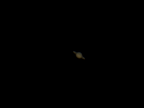On the drive home, I tried squinting at the sky, to see if I could see stars. Its not very easy though, as you are speeding along to try and glimpse them amongst the street lights and tail lights.
When I jumped out of the car though, it was clear that there were stars visible, and I rushed inside, and took the telescope outside immediately to start cooling down. There seems to be quite a lot of equipment to get carried out to get set up properly. Telescope, battery power tank, hand controller, selection of lenses, table, laptop, power cable for laptop, CCD camera, digital camera, star chart...
Anyway - in between grabbing some bites for tea, and not helping get the children into bed, and loosing the mains adapter, I managed to get all set up. I aligned the telescope, and then jumped to Mars as a first test. I wanted to try out some new ideas with the LPI camera and see what I could do. Unfortunately, Mars is now almost overhead, and the telescope doesn't like such objects quite as much. First its a little harder to see in that position - and the flexible focusing adapter is bent into a 90° angle. Another problem is with the Alt-Az mounting you are close to the issue of gimble lock. When looking upwards, which way is up/down and which way right/left. I'm confused, and so are the telescope motors. I know I want it to go THIS way, but its not so clear which way that is.
Anyway - I did get it on target, but I was rather disappointed with the results.

I think it is still overexposed, and clearly more work is needed.
So I waited for a while for the moon to rise. It is full at the moment, so very bright. It rose behind my increasingly least favourite tree in the neighbours garden! So I had a go at imaging that, and the results were better.

This was taken through the branches of the tree, so was subject to a bit of interference. It was about 80 images stacked together. The software has an option to save all the frames for later processing, so I took some more pictures to try processing later.
The moon was now out from behind the tree, and Saturn was very closely following it. I had a go at imaging Saturn through the tree, and managed to get some reasonable shots this time. As Saturn is very close to the moon, it is almost lost in the glow from it.


I saved the raw images again to process later. Finally, still not clear whether the LPI camera was giving better results, I took a high magnification lens, and connected the digital camera afocally to it, and took a movie of Saturn. By now I'd been outside in the cold for several hours and was running out of ideas, enthusiasm and warmth, so I wasn't as careful as I could be - it all gets a bit fiddly in the dark and concentration is hard to maintain. After processing in registax, it did look like a recognisable Saturn.

Its at a bit of an unusal angle as I had all sorts of issues getting the camera adapter aligned and connected without thumb screws running into each other.
So I took the telescope inside, and packed up. I then went and had a go at reprocessing the raw images, and the registax program is very good. It can be a bit tricky to work with, but the results were more impressive.



I was pleased to see some reasonable colours coming through too - perhaps I'd got the exposure better.
Finally, a quick processing of the saved moon images too for comparison.

Much better! A good evenings work, I wonder when the next one will come around! Looking out the bedroom window on the way to bed, I was pleased to see in a rather selfish way, that most of the sky was now obscured by cloud. My decision to pack away was vindicated.



No comments:
Post a Comment